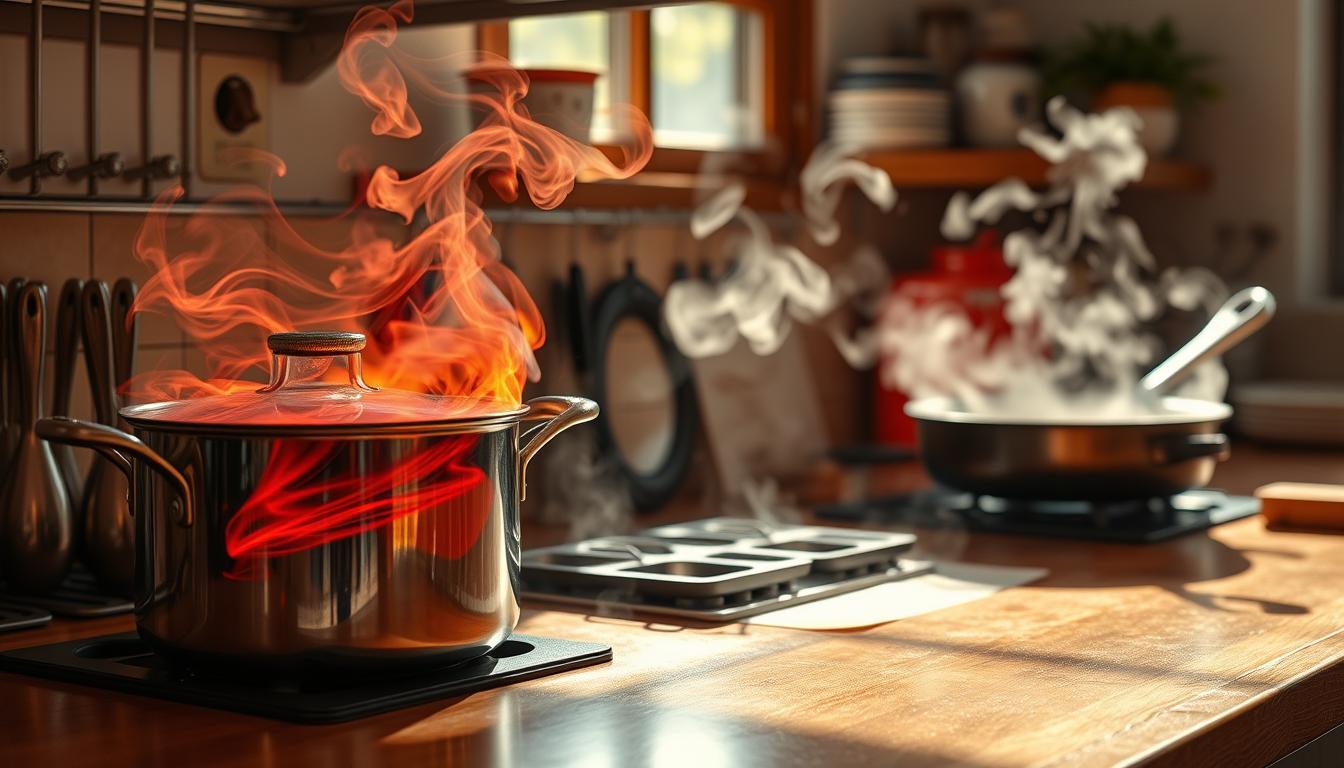While melting ice maintains 32°F water temperature despite added energy, this hidden thermal phenomenon impacts every meal you prepare. Understanding how particles transfer energy transforms ordinary dishes into extraordinary creations – and reveals why professional chefs consistently outperform amateur attempts.
Atoms never stop moving. Their vibrations determine both temperature perception and texture development in your meals. When you grasp how energy flows through pans, oils, and ingredients, you unlock precision that transcends recipe instructions. This knowledge explains why searing steak creates crusts faster than baking, or why vegetables steam better in certain cookware.
Mastering these concepts lets you adapt techniques across appliances. A cast iron skillet and air fryer both rely on energy distribution principles, though their methods differ dramatically. You’ll discover how to manipulate contact points between food and heat sources for ideal browning, tenderness, and moisture retention.
Key Takeaways
- Energy movement dictates cooking outcomes more than preset temperatures
- Material choices impact how efficiently heat reaches food surfaces
- Phase changes (like ice melting) absorb energy without temperature shifts
- Optimal texture comes from controlling energy transfer speed
- Professional results require understanding particle-level interactions
Understanding the Science of Heat and Energy Transfer
Every cooking process begins with an invisible dance of particles. Atoms and molecules vibrate constantly, creating the thermal energy that transforms raw ingredients into meals. This movement determines whether your steak sears perfectly or your vegetables steam unevenly.
What Is Heat? Unpacking Thermal Energy
Heat isn’t just warmth – it’s the kinetic energy of moving particles. When you sear meat, faster-moving molecules in the pan transfer energy to slower ones in the food. Water molecules in a boiling pot demonstrate this principle clearly, their rapid motion creating visible bubbles.

Temperature vs. Thermal Mass in Your Kitchen
Your oven’s display shows temperature, but your cookware’s thermal mass determines real results. Cast iron holds energy longer than aluminum because its dense structure absorbs more molecular motion. This explains why water-based methods cook faster – liquids transfer energy more efficiently than hot air.
Materials with high thermal mass act like batteries, storing energy for consistent cooking. A thick steel griddle stays ready for pancakes, while thin pans cool rapidly. You’ll master timing by matching cookware properties to your desired technique.
Kitchen Physics: Balancing Heat and Surface Area
Professional chefs achieve consistent results by mastering one critical factor: surface contact. How ingredients interact with their cooking environment determines everything from crispness to moisture retention.
The Role of Surface Area in Effective Cooking
Larger exposed areas let energy flow faster into your food. When boiling vegetables, water molecules collide with produce 23.5 times more frequently than air molecules during roasting. This explains why simmering cooks faster than baking at equal temperatures.

Denser mediums like broth or oil create more particle collisions per second. You’ll notice this when searing meat – full pan contact yields better browning than elevated racks. Strategic slicing or scoring increases exposed edges for uniform results.
How Heat Distribution Impacts Flavor and Texture
Controlled energy flow triggers the Maillard reaction – that golden crust on bread requires direct surface contact with precise temperatures. Spacing items properly allows hot air circulation, preventing steamed textures in oven-baked dishes.
Thermal gradients develop when energy transfers unevenly. Rotating pans or stirring ingredients balances these differences. You’ll retain vibrant colors in greens by blanching them briefly in rapidly moving water rather than steaming.
Exploring Methods of Heat Transfer in Cooking
Three invisible forces shape every dish you prepare. Mastering their distinct behaviors lets you control outcomes from crispy crusts to tender interiors. These energy pathways work silently but leave visible marks on your results.

Conduction: Cooking Through Direct Contact
Your skillet’s metal surface demonstrates this principle perfectly. When you sear fish, direct contact transfers energy 15 times faster than air exposure. Materials like copper excel here – their atomic structure allows rapid molecular vibrations.
Choose heavy-bottomed pans for even distribution. Thin cookware creates hot spots where proteins burn. You’ll achieve uniform browning by ensuring full contact between food and heated surfaces.
Convection: Harnessing Air and Water Currents
Modern ovens use fans to amplify this natural process. Circulating air eliminates cold zones, roasting vegetables 27% faster than conventional models. Liquids work similarly – boiling water moves heat through constant motion.
Position foods strategically in your appliance. Leave space between items to allow convection currents to flow freely. This prevents steaming and promotes caramelization in baked goods.
Radiation: Heat Waves and Infrared Cooking
Your grill’s glowing coals emit invisible waves that penetrate food surfaces. Unlike conduction, this method works without physical touch. Broilers use similar physics to create charred finishes on casseroles.
Adjust distances carefully. Radiation intensity decreases rapidly – moving steak 3 inches farther from flames can double cooking time. Combine this with other methods for complex flavor development.
Advanced Cooking Techniques and Kitchen Technology
Modern culinary innovations bridge science and artistry through precise environmental control. These tools harness thermal principles to achieve results impossible with conventional methods.

Sous Vide: Precision Through Controlled Conduction and Convection
Sous vide cooking locks ingredients in airtight bags submerged in temperature-regulated water. The vacuum seal eliminates air gaps that disrupt energy transfer, while circulating pumps maintain uniform heat distribution. You’ll achieve edge-to-edge doneness in meats because water conducts energy five times faster than air.
Advanced devices like the Anova Precision Cooker automate this process. Their convection currents prevent cold spots, ensuring proteins cook evenly without overcooking. This method proves why controlling molecular movement matters more than maximum temperatures.
Combi Oven: Integrating Steam and Dry Heat for Optimal Results
Professional kitchens use combi ovens to toggle between steam injection and convection heating. Steam transfers energy twelve times faster than dry air, rapidly cooking vegetables while preserving crunch. You’ll retain moisture in baked goods by adjusting humidity levels independently from heat settings.
These appliances demonstrate hybrid thermal strategies. In combination mode, steam penetrates food surfaces while convection currents crisp exteriors. You gain texture control that single-method cooking can’t match – tender centers with caramelized crusts in one cycle.
Practical Tips for Optimizing Your Cooking Environment
Transform ordinary meals into restaurant-quality dishes by mastering your appliance’s thermal behavior. The relationship between energy flow and ingredient preparation determines success more than following timers blindly.
Adjusting Temperature and Heat Source for Perfect Results
Air’s low heat capacity explains why ovens react faster to adjustments than water baths. For every 25°F change in dry air environments, cooking times shift 12-18% compared to liquid-based methods. Use this knowledge when baking:
- Lower racks intensify heat energy transfer near convection fans
- Steam trays boost thermal conductivity by 40% in standard ovens
- Rotate pans halfway through roasting to counter hot spots
Balancing Heat and Surface Area in Your Favorite Recipes
Thinly sliced vegetables cook 3x faster than whole pieces due to increased exposure. Apply this principle when adapting recipes:
“Surface contact dictates browning speed more than maximum temperatures. A medium-heat pan with full food coverage outperforms high heat with gaps.”
Test these adjustments:
- Press burgers flat for uniform searing
- Space cookies 2 inches apart for even baking
- Score fish skin to prevent curling
Conclusion
The secret to exceptional results lies beyond temperature dials and timers. Energy movement dictates outcomes more than any preset number. You now hold the key to controlling how molecules interact with your ingredients.
Different methods serve distinct purposes. Rapid heat transfer through direct contact creates crusts, while gentler convection preserves moisture. Your choice depends on desired textures and the science behind each technique.
With this knowledge, you can troubleshoot failed recipes and adapt cooking approaches. Recognize why sous vide achieves uniform doneness or how convection currents accelerate roasting. These principles elevate your efficiency across all appliances.
Experiment confidently. Adjust contact surfaces, monitor energy flow, and observe molecular interactions. Your results will reflect the precision of professional kitchens – one calculated particle collision at a time.



